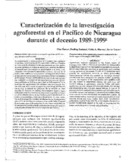Caracterización de la investigación agroforestal en el Pacífico de Nicaragua durante el decenio 1989-1999
Alternative title
Characterization of the agroforestry research conducted in the Pacific region of Nicaragua (1989-1999)
Description
2 ilus. 3 tab. 3 ref.
Abstract
Se caracterizaron y documentaron las investigaciones realizadas en sistemas agroforestales (SAF), entre 1989 y 1999 en el Pacífico de Nicaragua. Se identificaron las organizaciones que han realizado investigaciones, se realizaron entrevistas a personal de diferentes instituciones que trabajan en agroforestería y se revisó la bibliografía y documentación agroforestal existente. Un total de 15 instituciones estuvieron trabajando en investigación agroforestal, de las cuales la Universidad Centroamericana (UCA) y el Instituto de Tecnología Forestal (INTECFOR) fueron los que más trabajos han realizado. La mayoría de las organizaciones cuentan con personal calificado en SAF, pero pocos han recibido capacitación en investigación agroforestal. Los sistemas más investigados fueron SAF con café y cacao, taungya, sistemas silvopastoriles, barreras vivas y cultivos en callejones. Se ha incluido en estos sistemas 53 especies de plantas especialmente madero negro (Gliricidia sepium) y leucaena (Leucaena leucocephala). La mayoría de los estudios fueron de tipo biofísico pocos consideraron variables socioeconómicas. Hubo poca diseminación de estos resultados de la investigación y muchos estudios no fueron documentados sólo el 9 por ciento de los estudios resultaron en una publicación. El escaso financiamiento para la investigación y la poca importancia dada a la documentación y publicación de resultados fueron las principales limitantes para el desarrollo de la investigación agroforestal. Agroforestry research conducted in the Pacific region of Nicaragua from 1989 to 1999 was characterized and documented by identifying organizations that conducted agroforestry research, interviewing technicians who work in agroforestry and reviewing existing agroforestry documents. A total of 15 institutions were carrying out agroforestry research, of which Universidad Centroamericana (UCA) and Instituto de Tecnología Forestal (INTECFOR) have conducted the greatest number of studies research. The majority of the organizations have qualified staff who are trained in agroforestry systems, but most have not received training in agroforestry research. Coffee and cacao agroforestry systems, taungya, silvopastoral systems, live barriers and alleycropping were the must studied systems. A total of 53 plant species were included in these studies, especial madero negro (Gliricidia sepium) and leucaena (Leucaena leucocephala). Most of the research has been biophysical few studies have considered socioeconomic factors. There has been little dissemination of these research results and many studies were never documented publications resulted from only 9 percent of the studies. Agroforestry research is principally limited by the lack of financing and the limited emphasis given to research and publication.
Keywords
Publisher
CATIE, Turrialba (Costa Rica)


